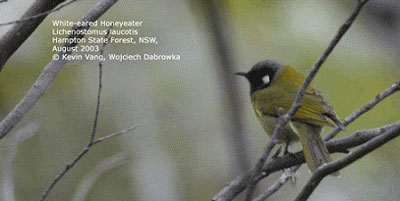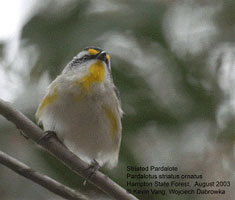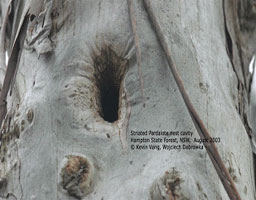1.0 OVERVIEW
Hampton is located on the top of the Great Dividing Range. The Jenolan Caves road to Hampton gives some panoramic views to the east of the Blue Mountains plateau and the Kanimbla Valley. The two most notable features of Hampton are the Halfway house and the windmills. The Halfway House was so named because it was halfway between the railway at Mt Victoria and the Caves. It was a welcome resting place for sightseers to the caves when they used to travel using charabancs (open sightseeing coaches). The area also has a long history of settlement commencing shortly after the crossing of the mountains when a variety of farming was undertaken including cattle and horses. The area has also seen prospecting for gold, a source of granite and crushed stone for Sydney and the establishment of large tracts of State Forest for timber. Streams in the area are rich in trout, and many are the homes for platypus and other wildlife.
At the invitation of the Alder family who live adjacent to the State Forest on Wicketty War Creek, a 2-person team of Kevin Vang and Wojciech Dabrowka from the Birdlife Australia Sydney Office spent 2 days, August 23-24, 2003, surveying and photographing the birds in the area.
David and Suzanne Alder recently bought a property here, and were keen for Birdlife to survey the area in order to help foster bird watching and nature tourism in the area. Their property is easily reached from Sydney. After a 2-hour road trip from Sydney to Katoomba, one continues on the Great Western highway until the Jenolan Caves turnoff. The property is at the very end (about 2km) of Wicketty War Road. This is a right hand turn off Jenolan Caves Road about 1km towards Jenolan Caves past the Halfway House immediately opposite the Hampton Homestead. Wicketty War road is a good quality dirt road. About 2km along the road you come to a loose open gate across the road, you go through this gate and 700m further you come to a second gate. This bears the property name "Brynmawr". The Alders home is on the hill to the left as you come through the gate.
We stayed at the Hampton Hotel, which is the main motel/pub/restaurant for the town, but there are many other accommodation options around Katoomba and Oberon, which are a bit farther away.
The weather was not very cooperative as a wicked winter storm with very high winds came roaring over the ridges during the survey. This kept bird numbers down, but a total of 29 species were sited and on a good day, several more would be possible.
The birdlife is typical of the Blue Mountain biozone. The elevations of the survey area were between 800-1250 m. The highlight of the trip was a breeding pair of the
ornatus sub-species of the
Striated Pardalote that had its nest in the hollow of a eucalypt. Several photos were taken of this.
2.0 CONTACT INFORMATION
David and Suzanne Alder welcome birdwatchers to the area and can be contacted to provide information about the area. Their email is David Alder, s-dalder at bigpond.com
3.0 SPECIES LIST
The Alder family had already developed a species list for the area. We were able to add to this list, and now have a total of 47 species for the area. The following is a combined list of 47 species both seen on our survey and those noted on the Alder's list. As people continue birding in the area, the Alders will continue to update the list.
White-faced Heron, Egretta novaehollandiae
One seen in field at Waypoint 363, 989 m, 23-24 August 2003. This species was not on the original list and is likely confined to open stream sides and fields.
Great Cormorant, Phalacrocorax carbo
Not seen on the survey, but seen occasionally flying up and down Wicketty War Creek or sitting on creek or dam edge. Little Pied or Little Black Cormorants are also likely in similar habitat in this area.
Pacific Black Duck, Anas superciliosa
Pair seen in flooded roadside field at Waypoint 363, 989 m, 24 August 2003. These are common in often in pairs along Wicketty War Creek.
Australian Wood Duck, Chenonetta jubata
Pair seen along Wicketty War Creek along creek down to dam at Waypoint 361, 861 m, 23 August 2003. . This species was not on the original list but should be common along open areas along the creek and in small dams in open fields adjacent to the area.
Grey Goshawk, Accipiter novaehollandiae
Not seen on the survey, but resident pairs in the area are occasionally seen.
Wedge-tail Eagle, Aquila audax
Not seen on the survey, but commonly seen overflying hills and fields and occasionally perched in forest.
Brown Falcon,
Falco berigora
Not seen on the survey, but commonly seen particularly perched in open and exposed areas.
Nankeen Kestrel, Falco cenchroides - Not seen on survey, but a pair settled in the valley during the 2003-2004 summer and were regularly seen feeding in the gully near the house.
Sulphur Crested Cockatoo, Cacatua galerita
Common in forests along Wicketty War Creek at Waypoint 358, 1000-1020 m, 23 August 2003. This is a common and conspicuous resident.
Galah, Cacatua roseicapilla
Few seen fields along road at Waypoint 363, 989 m, 24 August 2003. Generally common, but in more open areas around forest.
Gang Gang Cockatoo, Callocephalon fimbriatum
Not seen on the survey, but commonly heard and seen in forest.
Yellow-tailed Black Cockatoo, Calyptorhynchus funereus
Not seen on the survey, but large flocks are conspicuous and common throughout the area.
Australian King Parrot,
Alisterus scapularis
Not seen on survey but observed once at the house.
Crimson Rosella, Platycerus elegans
Very common in forests and brush along Wicketty War Creek up onto the tops of hills at Waypoint 358-363, 980-1220 m, photographed, 23-24 August 2003.
Eastern Rosella, Platycerus eximius
Common in fields and forest edge along Wicketty War Creek at Waypoint 358-363, 980-1100 m, 23-24 August 2003.
Tawny Frogmouth, Podgarus strigoides
Not seen on the survey, but likely to be spotted in dusk or at night on posts, wires and branches along dirt roads in area.
Common Bronzewing,
Phaps chalcoptera
Not seen on the survey, but common in forest and scrub in area.
Laughing Kookaburra, Dacelo novaeguineae
Common and noisy in forests along Wicketty War Creek and throughout the forest up onto tops of peaks at Waypoint 358-360, 1000-1220 m, photographed, 23-24 August 2003.
Superb Lyrebird, Menura novaehollandiae
Not seen on the survey, but common in forest areas.
Eastern Whipbird, Psophodes olivaceus
Heard, but not seen on the survey. Common in forest areas.
Black faced Cuckoo-shrike, Coracina novaehollandiae
Not seen on the survey, but individuals commonly on forest edge.
Welcome Swallow, Hirundo neoxena
Hawking over fields along Wicketty War Creek between Waypoints 358-362, 900-1020 m, 23-24 August 2003.
Superb Fairy Wren, Malurus cyaneus
Common in brush along Wicketty War Creek Waypoints 358, 364, 930-1020 m, photographed, 23-24 August 2003.
Yellow-rumped Thornbill, Acanthiza chrysorrhoa
Common in brush along Wicketty War Creek Road, Waypoints 363, 980-990 m, 24 August 2003.
Striated Thornbill, Acanthiza lineata
Common in forest also in brush along Wicketty War Creek Waypoints 364, 930 m, photographed, 24 August 2003.
Brown Thornbill, Acanthiza pusilla
Common in forest and in brush along Wicketty War Creek Waypoints 364, 930 m, photographed, 24 August 2003.
Buff Rumped Thornbill, Acanthiza reguloides
Not seen on the survey, but noted as common in forest and adjacent open areas.
White-browed Scrubwren, Sericornis frontalis
Very common in brush along Wicketty War Creek, Waypoint 358, 364; 930-1020 m, photographed, 23-24 August 2003.
Grey Fantail, Rhipidura fuliginosa
Few seen in brush along Wicketty War Creek, Waypoints 364, 930 m, 24 August 2003.
Grey Shrike-Thrush, Colluricincla harmonica
Few seen and heard calling in forest along Wicketty War Creek Waypoint 358-359, 990-1020 m, 23 August 2003.
Golden Whistler, Pachycephala pectoralis
One male seen in forest along Wicketty War Creek, Waypoint 358, 1017 m, 23 August 2003.
White-throated Treecreeper, Climacteris leucophaea
Common in brush along Wicketty War Creek Waypoint 364, 930 m, photographed, 24 August 2003.
Brown Treecreeper, Climacteris picumnus
Not seen on the survey, but noted in open areas around forest, probably not as common as White-throated Treecreeper. Red-browed Treecreeper should also be present in deep forest.
Striated Pardalote, Pardalotus striatus ornatus
Pair seen in forest along Wicketty War Creek, coming in and out of nest hollow in eucalypt, also perching singing loudly, possibly nesting, Waypoint 358, 1000 m, extensively photographed, 23 August 2003.
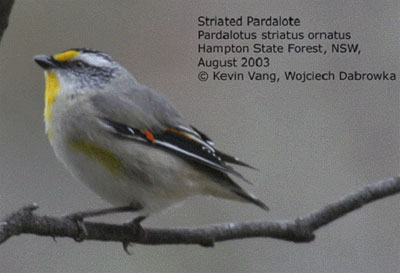 Eastern Spinebill, Acanthorhynchus tenuirostris
Eastern Spinebill, Acanthorhynchus tenuirostris
Common in forest and low brush along Wicketty War Creek, Waypoint 358, 364 930-1000 m, extensively photographed, 23-24 August 2003.
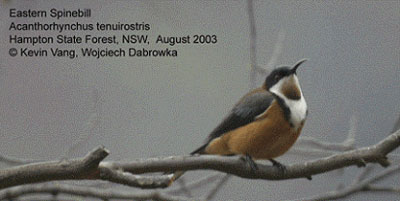 Red Wattlebird, Anthochaera carunculata
Red Wattlebird, Anthochaera carunculata
One seen in forest above Wicketty War Creek, Waypoint 358, 1050 m, 23 August 2003.
White-eared Honeyeater, Lichenostomus laucotis
Common in forest along Wicketty War Creek, Waypoint 358, 980-1020 m, photographed, 23 August 2003.
Noisy Miner, Manorina melanocephala
Few seen in forest-field edge at Wicketty War Creek, Waypoint 358, 1000-1020 m, photographed, 23 August 2003.
New Holland Honeyeater, Phylidonyris novaehollandiae
Common in brush along Wicketty War Creek, Waypoint 364, 930 m, photographed, 24 August 2003.
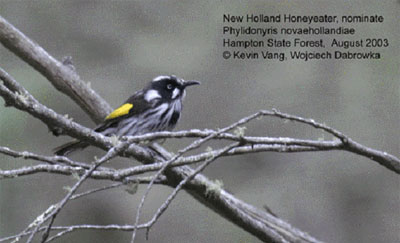 Noisy Friarbird, Philemon corniculatus
Noisy Friarbird, Philemon corniculatus
Not seen on the survey, but occasional in forest areas and forest edge.
European Starling, Sturnus vulgaris
Common in fields along Wicketty War Creek Road before forest, Waypoint 362, 900-1100 m, photographed, 23-24 August 2003.
Satin Bowerbird, Ptilonorhynchus violaceus
Not seen on survey but were regular feeders on the strawberries during the 2003-2004 summer.
Australian Magpie-lark, Grallina cyanoleuca
One seen in brush along Wicketty War Creek Waypoint 363, 989 m, 24 August 2003.
Grey Butcherbird, Cracticus torquatus
Not seen on the survey, but occasional in open areas around forest.
Australian Magpie, Gymnorhina tibicen
Common in fields along Wicketty War Creek Road before forest, Waypoint 358-362, 1000-1100 m, 23 August 2003.
Pied Currawong, Strepera graculina
Common in Hampton town and open area, Waypoint 362,1100 m, 23 August 2003.
Australian Raven, Corvus coronoides
Common in forest and overflying along Wicketty War Creek, Waypoint 362, 900-1100 m, 23-24 August 2003.
